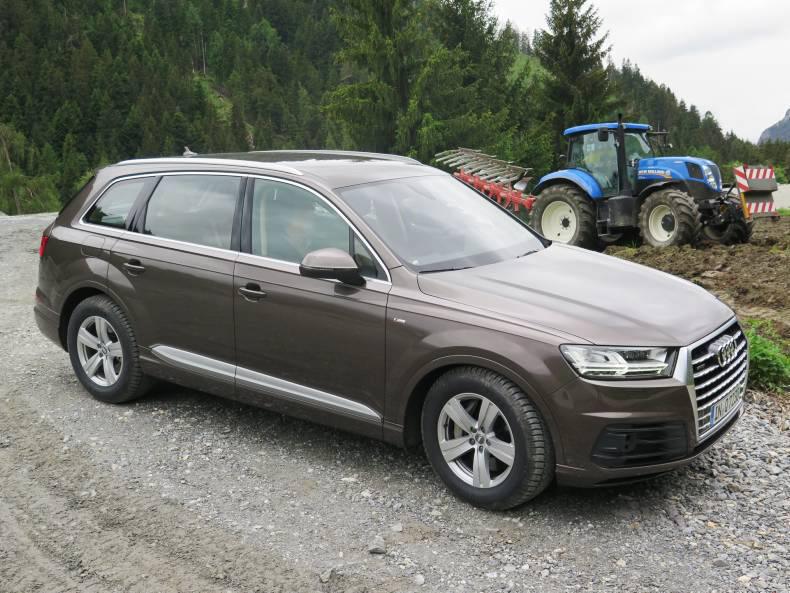Audi has reshaped the Q7, its flagship SUV model, to make it lighter, quieter and more economical. The new design is also less imposing on the road, while packing a serious level of driving performance.
Last week, Audi launched the car in Switzerland. The driving conditions were steep and hilly, as you would expect from that country, and were deliberately chosen to test the engine torque and road-holding ability of Audi’s latest SUV.
The Q7 is refreshing in terms of looks. It aims to dislodge the BMW X5 as the leading premium-end SUV on the Irish market, and comes at a time when Volvo has new competition on the way in the shape of an impressive new XC90.
The new Audi Q7 makes a new statement in that it is lower than the older version and less imposing on the road. It is longer, narrower and lower than BMW’s X5. And while Audi has shaved 325kg from the weight of the car compared with the older version, it’s still marginally heavier than BMW’s offering.
Audi claims to have boosted the power of the new Q7. The engine is impressively smooth and quiet on the road. We tested two different power versions of the car during the Swiss test drive – both are powered by a 3.0-litre V6 turbo-diesel engine that’s rated either at 218bhp or 272bhp.
The higher-powered version of the two has noticeably more pace, even if on paper there is no acceleration difference. The Q7 can accelerate with ease and the eight-speed automatic gearbox was the perfect complement, in terms of smoothness, to that quiet engine.
The acceleration is smoother than that of the BMW X5, which means a quieter cabin. The 18- inch Goodyear tyres on the test car helped to give a comfortable ride.
The new Q7 has a slightly better economy figure than the BMW X5, with claims of 17km/litre (5.9/100km or 48mpg), but these were difficult to assess during the first test drive. This is a significant improvement over the previous model and helps to bring the Q7’s CO2 figures down to 153g CO2/km. That makes ownership easier as the road tax is band c (€390) and brings with it a fuel economy improvement of 28%, according to Audi.
This Q7 will be sold in Ireland as a seven-seat SUV, with a good specification kit as standard. That includes the Audi Quattro 4x4 system and leather seating. However, I’m a bit disappointed that the reversing camera is an extra, as it is especially useful, even essential, for a car as long as the Q7.
There are lots of other impressive features, including a new trailer reversing system that’s easy to use. When you go for this option, which adds over €2,000 to the price, you also get additional towing power, up from 2.7t to 3.5t, so that will be a must for anyone with trailer-towing ambitions.
The options for the new Q7 are as impressive as they are lengthy. I especially liked the virtual cockpit option that I’ve driven in the Audi TT and it will be standard on the S-Line versions of the Q7, that are a minimum of €6,900 more expensive than the base model.
Audi has pushed the Q7 into new technology territory, with an impressive interactive system that includes twin Audi tablets for rear passengers.
There are numerous other safety features to help the driver to avoid collisions and make parking easier. The car has pioneered a new rear-wheel-steering system that gives opposite angle steering at low speeds for tighter parking and then automatically converts to a crab steering system when used at higher speeds, giving safer motorway manoeuvres.
The new Q7 is luxury territory in terms of car ownership and there is a price to pay for that. Entry prices are high at €72,975 or £50,340 in Northern Ireland. The Q7 will not be available here until January 2016 but it is a smooth and powerful car that’s very pleasant to drive.
Q7 3.0 TDI 272 Quattro
Engine 3.0-litre
Engine power 272hp
0-100km/hr 6.5 seconds
Economy 17km/litre
Fuel tank capacity 75 litres
CO2 emissions 153g/km
Road tax band C €390
Main service 20,000km
Towing rating 2,700kgs
Warranty Three years
Entry price €72,975
NI price £50,340






 This is a subscriber-only article
This is a subscriber-only article




















SHARING OPTIONS: